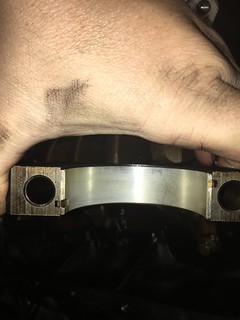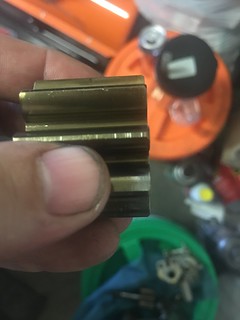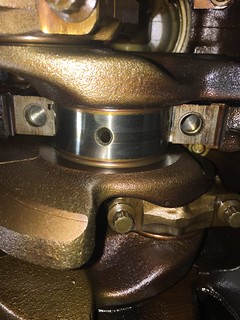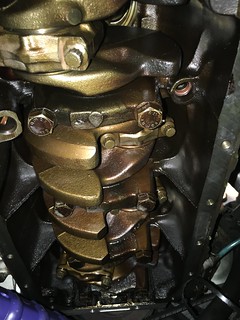dmann
New member
- Joined
- Apr 22, 2015
- Location
- Sacramento CA
I am working on a 1995 940 w/b230. The odometer reads about 193K miles. I just recently purchased this vehicle. What I originally thought was probably piston slap I now believe is a rod knock.
The noise is not present when the car is started when cold. After a short drive, it becomes noticeable. I hear it at stoplights, sometimes I notice it when accelerating (slowly) and when decelerating. It's not the loudest sounding knock I've heard by any means, but I don't want it to get any worse.
I pulled the pan off to get a look at the bearings and check the clearances. Number 2 rod bearing showed the most wear on the upper shell, with some copper showing, about 10% of the upper surface showed some copper. The other bearing shells seem to be in pretty good shape if they actually have 193K miles on them.
I wiped the bearings and the crank journal off and then used plastigage on them. I get between 1.5 and 2.5 thousandths on all of them. I tried plastigage on each journal more than once, hoping to increase the chance of detecting any errors during measurement. They always seem to come out in that range. I tried a little experiment with rod number 1, I took some .001 thick foil and shimmed the bottom of the rod cap underneath the used bearing. I then tightened everything back up and measured again with plastigage, and it did tighten up. It measured about .001 total clearance. I don't honestly know how accurate the plastigage is, because when removing the rod caps I have to tap the bolt to break the cap away from the rod. I'm concerned that this could impart a load on the cap, and flatten out the plastigage even more and throw off my readings.
With the bearings and journal mostly dry of oil I can get a small clanking sound on all 4 of the rods - if I try forcefully rocking them back and forth pushing on the rod from the driver side towards the passenger side and then doing the opposite. It requires a concerted effort to make that noise however, and I can't push up or pull down on the rod and make the noise. This test was done with the original bearings in place, not the new ones.
I don't know what the oil pressure is, I don't have any gauge, though I may pick one up. I purchased a new set of bearings and new oil pump o-rings.
None of the bearings are blue or appear discolored from heat, even though I've put about 1500 miles on it since I started to suspect a rod bearing.
I'm wondering if perhaps I have low oil pressure. The oil pump screen looked ok to me, and I didn't notice anything in the bottom of the pan that looked bad. There was some carbon build up on the surfaces of the lower end; more than I'd like to see, but a lot less than some engines I've seen.
I thought about checking the mains, but I think I might as well pull the engine if I was going to do that, because they look difficult to get out in chassis.
I guess at this point the best thing I could do would be to put it back together and check the oil pressure.
Any other ideas?
The noise is not present when the car is started when cold. After a short drive, it becomes noticeable. I hear it at stoplights, sometimes I notice it when accelerating (slowly) and when decelerating. It's not the loudest sounding knock I've heard by any means, but I don't want it to get any worse.
I pulled the pan off to get a look at the bearings and check the clearances. Number 2 rod bearing showed the most wear on the upper shell, with some copper showing, about 10% of the upper surface showed some copper. The other bearing shells seem to be in pretty good shape if they actually have 193K miles on them.
I wiped the bearings and the crank journal off and then used plastigage on them. I get between 1.5 and 2.5 thousandths on all of them. I tried plastigage on each journal more than once, hoping to increase the chance of detecting any errors during measurement. They always seem to come out in that range. I tried a little experiment with rod number 1, I took some .001 thick foil and shimmed the bottom of the rod cap underneath the used bearing. I then tightened everything back up and measured again with plastigage, and it did tighten up. It measured about .001 total clearance. I don't honestly know how accurate the plastigage is, because when removing the rod caps I have to tap the bolt to break the cap away from the rod. I'm concerned that this could impart a load on the cap, and flatten out the plastigage even more and throw off my readings.
With the bearings and journal mostly dry of oil I can get a small clanking sound on all 4 of the rods - if I try forcefully rocking them back and forth pushing on the rod from the driver side towards the passenger side and then doing the opposite. It requires a concerted effort to make that noise however, and I can't push up or pull down on the rod and make the noise. This test was done with the original bearings in place, not the new ones.
I don't know what the oil pressure is, I don't have any gauge, though I may pick one up. I purchased a new set of bearings and new oil pump o-rings.
None of the bearings are blue or appear discolored from heat, even though I've put about 1500 miles on it since I started to suspect a rod bearing.
I'm wondering if perhaps I have low oil pressure. The oil pump screen looked ok to me, and I didn't notice anything in the bottom of the pan that looked bad. There was some carbon build up on the surfaces of the lower end; more than I'd like to see, but a lot less than some engines I've seen.
I thought about checking the mains, but I think I might as well pull the engine if I was going to do that, because they look difficult to get out in chassis.
I guess at this point the best thing I could do would be to put it back together and check the oil pressure.
Any other ideas?







